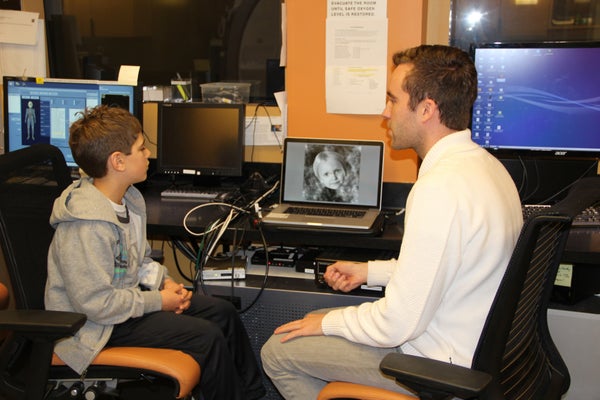Many of us are familiar with the feeling of passing someone in a supermarket or making eye contact on a crowded subway and wondering, Do I know that person? As we move through life we are tasked with remembering and recognizing thousands of faces, and a study released today in Science reveals our brains improve at this as we reach adulthood.
Researchers had children and young adults complete a combination of behavioral tests and anatomical and functional brain scans. They found that not only were the young adults better than the children at recognizing faces, they also had a stronger response in brain regions associated with facial recognition when they looked at faces, along with denser tissue in these areas. The findings suggest these changes in brain anatomy underlie our improving facial recognition skills.
Until age 10, children undergo a dramatic brain transformation known as synaptic pruning, in which unused brain connections are trimmed away and frequently used ones are strengthened, making their brains more efficient processing machines. Neuroscientist Kalanit Grill-Spector of Stanford University and her colleagues have previously shown that some visual brain areas mature early on, well within this pruning window—our ability to recognize inanimate objects, for example, is set by age seven. Our facial recognition skills, however, continue to improve into our 20s, which is what prompted the researchers to investigate the brain changes that occur between childhood and young adulthood.
On supporting science journalism
If you're enjoying this article, consider supporting our award-winning journalism by subscribing. By purchasing a subscription you are helping to ensure the future of impactful stories about the discoveries and ideas shaping our world today.
The team enrolled 22 children between ages of five and 12 and 25 adults between 22 and 28 in the study. In the first phase the researchers used MRI (magnetic resonance imaging) scans to capture detailed images of each subject’s brain anatomy. Then, participants underwent functional brain scans while looking at pictures (categorized as faces, bodily parts, objects, places or symbols), allowing researchers to see how selectively the brain regions associated with facial recognition responded to faces. Finally, participants completed a series of tests to assess their facial recognition skills, such as matching faces photographed in different lighting and from different angles.
The researchers found that, as in previous studies, adults were better than children at recognizing faces, and had a stronger response in facial recognition brain regions located in the fusiform gyrus when they looked at faces compared with when they saw other images. More unexpectedly, the tissue in these brain regions was denser in adults than it was in children—it contained a similar number of brain cells but more supporting structures that help them connect to one another. According to Grill-Spector, this denser tissue is evidence that tissue growth, rather than synaptic pruning, in the brain regions linked to facial recognition helps us get better at recognizing faces as we mature. “This suggests that there might be multiple mechanisms of development in the brain both throughout the lifespan and in different regions of the brain,” she says. The researchers are now delving further into these developmental changes by tracking brain changes in children as they mature.
Brad Duchaine, a neuroscientist at Dartmouth College who was not involved in the study, praises the researchers for “using a new approach to tackle a critical question in neural development.” For him, the study offers clear evidence that when it comes to fine-tuning the brain during development, “pruning isn’t the only game in town.” He adds that the study is particularly interesting within the context of neurodevelopmental conditions where facial processing is impaired, such as autism. “These findings raise the question of whether reduced tissue [growth] in [the brain's] face areas plays a role in the difficulties people with these conditions have with faces,” he says.
As far as why our facial recognition skills continue to improve even into young adulthood, there are a couple possibilities. One is that we may simply need to remember more faces. Grill-Spector explains that as we get older, “the size of our social circles expands quite profoundly” and an increasing capacity for facial recognition may help us keep pace. Another is that our brains may require more fine-tuning to differentiate faces, which look more similar than objects or places. “They all have the same parts and the same configuration,” Grill-Spector says, ”So you really have to become attuned to fine differences across people, and this refinement might require a lot of time.”
